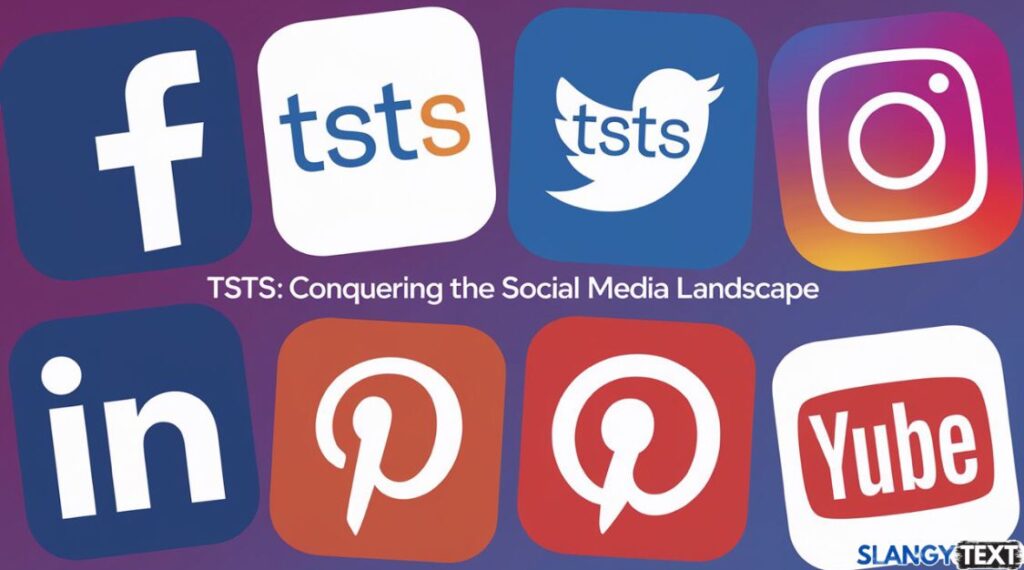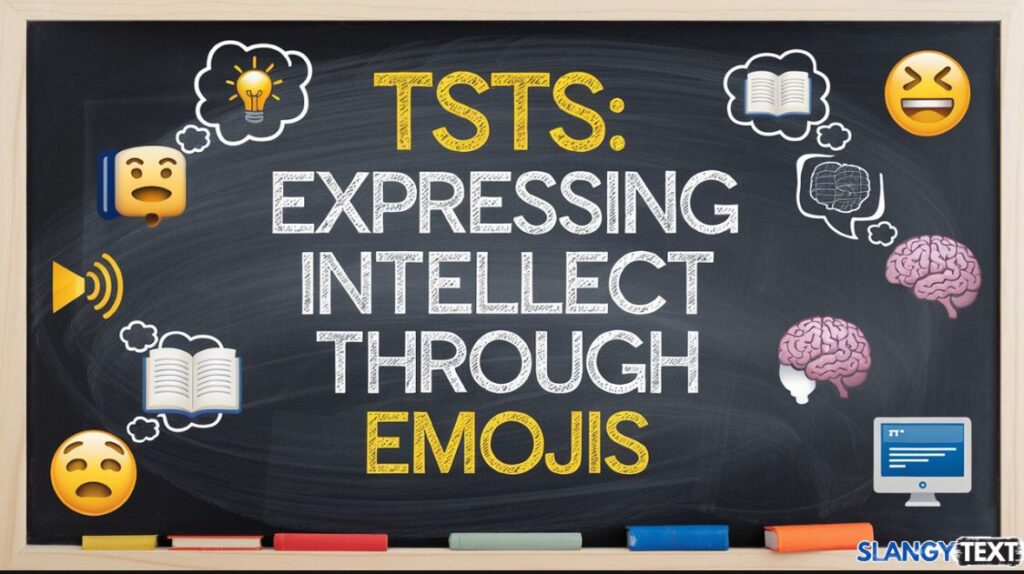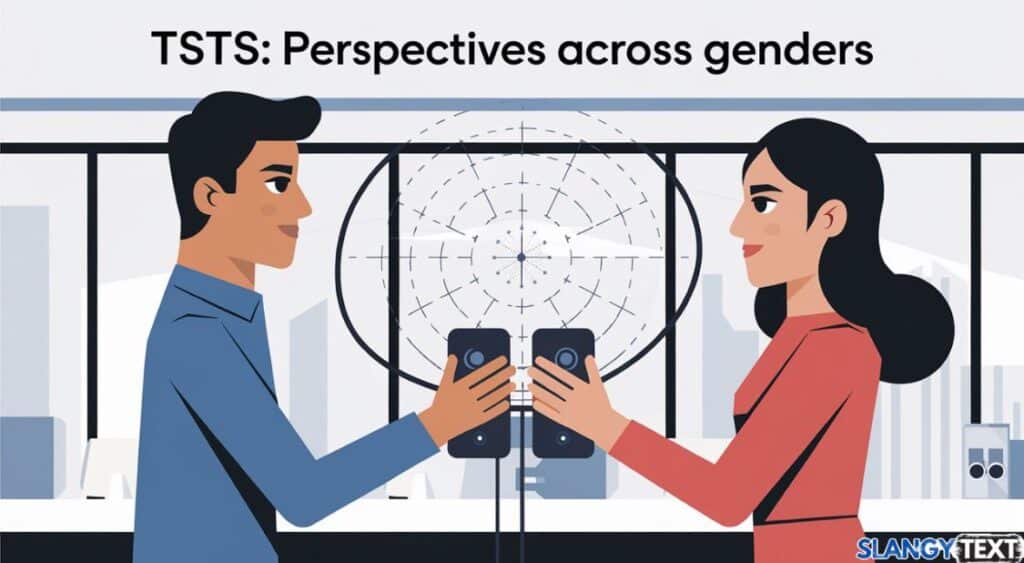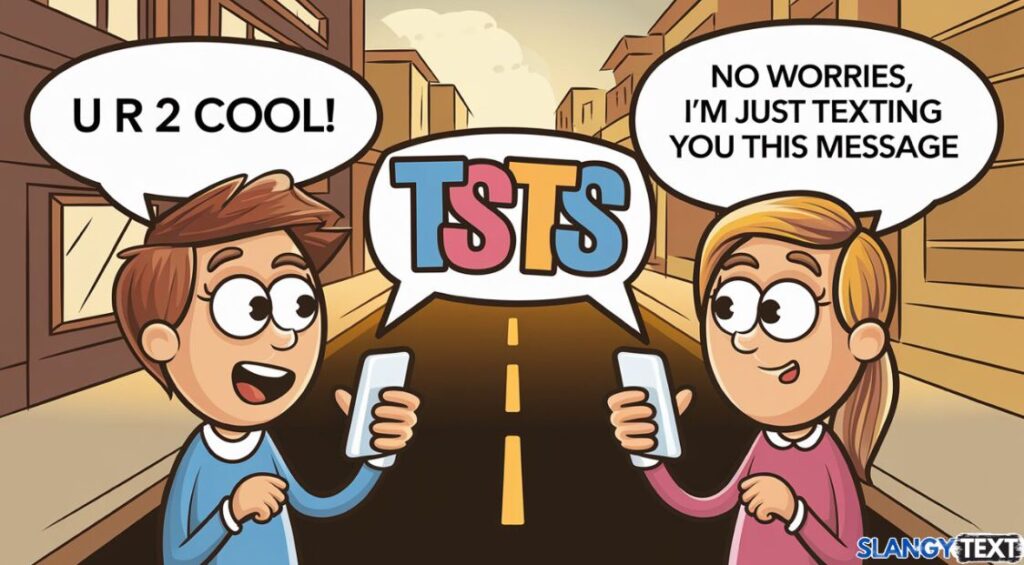This article delves into the meaning, usage, and implications of TSTS meaning in texting and online conversations.
In the ever-evolving landscape of digital communication, new acronyms and shorthand expressions emerge constantly. One such term that has gained traction in recent years is TSTS.
The Core Meaning of TSTS
TSTS stands for “Too Smart to Talk Foolish”. This phrase encapsulates a confident emotional state where the user considers themselves above engaging in trivial or unintelligent conversation. It’s a way of expressing that one values meaningful dialogue and is unwilling to spend time on unimportant communications.
TSTS in Social Media Platforms

The use of TSTS has spread across various social media platforms, including TikTok, Snapchat, and Instagram. Its popularity stems from its brevity and the attitude it conveys. Users often employ it to assert their intelligence or to dismiss conversations they deem unworthy of their time.
Here’s a table showcasing how different users might incorporate TSTS in their social media bios:
| Name | Platform | Bio Example | ||
|---|---|---|---|---|
| Emma | “TSTS 🧠 \ | Photography enthusiast \ | NYC” | |
| Liam | TikTok | “Memes and dreams 😎 TSTS vibes only” | ||
| Olivia | Snapchat | “Living my best life 💖 TSTS always” | ||
| Noah | “Tech geek \ | Coffee \ | TSTS mode 24/7″ | |
| Ava | “Marketing professional \ | TSTS in business and life” | ||
| Ethan | “Adventure seeker \ | TSTS \ | Ask me anything” | |
| Sophia | “DIY queen 👑 TSTS when it comes to crafts” | |||
| Mason | “r/science mod \ | TSTS \ | Change my mind” | |
| Isabella | YouTube | “Vlogger \ | TSTS \ | Subscribe for smart content” |
| William | Twitch | “Pro gamer \ | TSTS \ | Let’s outsmart the competition” |
TSTS in Text Messaging
In the realm of text messaging, TSTS serves as a quick way to convey one’s state of mind or attitude towards a conversation. It can be used to redirect a chat towards more substantial topics or to politely decline engaging in gossip or idle chatter.
Consider this example exchange:
Sarah: “Hey, did you hear about the latest celebrity breakup?” Michael: “TSTS. Let’s talk about that new scientific discovery instead.”
In this scenario, Michael uses TSTS to express his disinterest in celebrity gossip and steer the conversation towards a topic he considers more intellectually stimulating.
Also like to know this : What Does Wsu Mean in Texting (Real-Life Examples)
Alternate Meanings and Usages
While the primary meaning of TSTS in texting is “Too Smart to Talk Foolish”, it’s worth noting that acronyms can have multiple interpretations depending on the context. Some alternate meanings of TSTS include:
- Twin State Technical Services
- Transaction Switching & Transport Service
- Time Space Time Space (in certain scientific contexts)
It’s crucial to consider the context when interpreting TSTS, as its meaning can vary depending on the field or industry in which it’s used.
TSTS and Emoji Combinations

In the world of digital communication, emojis often accompany acronyms to enhance or modify their meaning. TSTS is no exception. Users frequently pair it with emojis that reinforce the sentiment of intelligence or dismissal.
Here’s a table illustrating common emoji pairings with TSTS and their nuanced meanings:
| TSTS + Emoji | Name | Implied Meaning |
|---|---|---|
| TSTS 😎 | Sunglasses | Confident and unbothered |
| TSTS 🧠 | Brain | Emphasizing intelligence |
| TSTS 🤓 | Nerd Face | Proudly smart |
| TSTS 🙄 | Rolling Eyes | Dismissive of nonsense |
| TSTS 🤔 | Thinking Face | Contemplating deeper topics |
| TSTS 💡 | Light Bulb | Having intelligent ideas |
| TSTS 📚 | Books | Valuing knowledge |
| TSTS 🤐 | Zipper-Mouth Face | Choosing not to engage |
| TSTS 🦉 | Owl | Symbol of wisdom |
| TSTS 🔬 | Microscope | Focused on precise, scientific thinking |
TSTS as a Potential Typo
In some cases, TSTS might appear as a typo for “tests”. This can lead to confusion, especially in educational or professional contexts. It’s essential to pay attention to the surrounding text to determine whether TSTS is being used intentionally or if it’s a mistype.
For instance:
Teacher: “Don’t forget, we have TSTS next week.” Student: “Do you mean tests or TSTS?” Teacher: “Oh, sorry for the typo. I meant tests!”
This exchange highlights the importance of clarity and context when using acronyms or shorthand in text-based communication.
Gender Perspectives on TSTS Usage
While TSTS is generally gender-neutral, some users have noted slight variations in how it’s employed across genders. These observations are generalizations and don’t apply to all individuals.

TSTS from a Girl’s Perspective
When used by female texters, TSTS often carries the connotation of being too clever for silly chatter. It can be a way to assert intelligence and avoid conversations that might be perceived as frivolous or stereotypically “girly”.
Here’s a table showing examples of how girls might use TSTS in various scenarios:
| Name | Scenario | TSTS Usage |
|---|---|---|
| Emily | Responding to gossip | “TSTS. Let’s discuss our book club instead.” |
| Sophie | Avoiding small talk | “TSTS. How about we plan our study group?” |
| Zoe | Deflecting a pickup line | “Nice try, but TSTS. What’s your take on climate change?” |
| Mia | In a work chat | “TSTS. Can we focus on the project deadlines?” |
| Lily | During a game night | “TSTS. Who’s up for some chess?” |
| Grace | On a dating app | “TSTS. Tell me about your career aspirations.” |
| Chloe | In a friend group chat | “TSTS. Anyone want to join my coding workshop?” |
| Ella | Responding to a meme | “Cute, but TSTS. Seen the latest space exploration news?” |
| Ava | During a class discussion | “TSTS. Let’s dive deeper into the theory.” |
| Hannah | At a party | “TSTS. Who wants to debate philosophy?” |
You might also like this too: What Does WU Mean In Texting?
TSTS from a Guy’s Perspective
Male users might employ TSTS to express a desire for meaningful conversations or to avoid topics they consider unnecessary or beneath their intellectual level. It can also be a way to project confidence and intelligence.
Consider this table of examples showing how guys might use TSTS:
| Name | Scenario | TSTS Usage |
|---|---|---|
| Alex | In a group chat | “TSTS. Anyone interested in discussing the stock market?” |
| Ryan | On a dating profile | “TSTS. Looking for someone who can challenge me intellectually.” |
| Daniel | During a work meeting | “TSTS. Let’s focus on innovative solutions.” |
| Jason | In a sports discussion | “TSTS. How about we analyze the game strategies?” |
| Chris | Responding to a joke | “Haha, but TSTS. What are your thoughts on AI advancements?” |
| Matthew | In a social setting | “TSTS. Who wants to join my debate club?” |
| Andrew | On social media | “TSTS. Check out my latest tech review video.” |
| David | During online gaming | “TSTS. Let’s discuss optimal team compositions.” |
| James | In a family group chat | “TSTS. How about we plan an educational family trip?” |
| Michael | At a networking event | “TSTS. I’d love to hear about your industry insights.” |
The Fine Line Between Confidence and Arrogance
While TSTS can be a powerful tool for asserting one’s intellectual stance, it’s crucial to use it judiciously. Overuse or misuse of TSTS might come across as arrogant or dismissive, potentially alienating friends, colleagues, or romantic interests.
Consider the following exchange:
Jake: “Did you see that amazing goal in last night’s game?” Sarah: “TSTS. I don’t waste time on sports. Let’s discuss quantum physics.”
In this case, Sarah’s use of TSTS might be perceived as unnecessarily condescending, potentially damaging her relationship with Jake.
TSTS and Professional Communication
In professional settings, the use of TSTS requires careful consideration. While it might be appropriate in casual workplace chats among peers, it could be seen as unprofessional or disrespectful in more formal communications.
Here’s a table illustrating the appropriateness of TSTS in various professional scenarios:
| Scenario | Appropriateness | Alternative Approach |
|---|---|---|
| Team chat with close colleagues | Potentially okay | “Let’s focus on more pressing matters.” |
| Email to a client | Inappropriate | “I suggest we discuss more relevant topics to our project.” |
| Job interview | Highly inappropriate | “I’m eager to engage in meaningful discussions about the role.” |
| Performance review | Inappropriate | “I’m committed to productive and insightful conversations.” |
| Networking event | Use with caution | “I’m particularly interested in substantive industry discussions.” |
| Company-wide announcement | Inappropriate | “We encourage thoughtful and productive dialogue.” |
| One-on-one with manager | Potentially okay if close relationship | “I’d like to discuss more impactful aspects of our work.” |
| Customer service interaction | Highly inappropriate | “Let me help you with more pertinent information.” |
| Professional social media | Use with caution | “Seeking connections for intellectual discourse in [field].” |
| Conference or seminar | Potentially okay in casual settings | “I’m here to engage in thought-provoking conversations about [topic].” |
also like to know this : What Does WRD Mean In Text?
The Evolution of TSTS
Like many internet slang terms, TSTS has evolved since its inception. Its usage has spread from niche online communities to mainstream social media platforms. As it gains popularity, its meaning and connotations continue to shift subtly.
Early adopters of TSTS often used it in tech-savvy or academically-oriented online spaces. Now, it’s not uncommon to see TSTS used in various contexts, from casual social media posts to semi-professional networking sites.
TSTS and Related Expressions
TSTS is part of a broader category of internet slang that expresses intellectual superiority or dismissal of trivial matters. Other related expressions include:
- TL;DR (Too Long; Didn’t Read)
- ELI5 (Explain Like I’m 5)
- IANAL (I Am Not A Lawyer)
These acronyms serve different purposes but share the common thread of conveying a specific intellectual stance or approach to information.
The Impact of TSTS on Communication Styles
The rise of expressions like TSTS reflects a broader trend in digital communication towards brevity and attitude. These shorthand phrases allow users to quickly convey complex sentiments or states of mind, potentially at the cost of nuance.
Consider how TSTS might shape a conversation:
Emma: “What do you think about the latest celebrity scandal?” Liam: “TSTS. Have you read any good books lately?”
In this exchange, Liam’s use of TSTS efficiently communicates his disinterest in gossip and redirects the conversation towards what he considers a more worthwhile topic.
TSTS and Online Persona Building
For some users, incorporating TSTS into their online communication becomes part of their digital persona. It can be a way to brand oneself as intellectually oriented or discriminating in one’s interests and conversations.
Here’s a table showing how different online personas might incorporate TSTS:
| Persona Type | Bio Example | TSTS Usage |
|---|---|---|
| Tech Enthusiast | “Coding wizard 💻 TSTS about the latest tech” | In discussions about cutting-edge technology |
| Bookworm | “Bibliophile 📚 TSTS, always seeking literary discourse” | When recommending complex novels |
| Scientist | “PhD candidate 🔬 TSTS in the lab and in life” | During explanations of research findings |
| Philosopher | “Existentialist thinker 🤔 TSTS, let’s ponder life’s mysteries” | In debates about ethical dilemmas |
| Entrepreneur | “Startup founder 💼 TSTS about business strategies” | When discussing market trends |
| Fitness Coach | “Health optimizer 💪 TSTS, ask me about holistic wellness” | In conversations about advanced nutrition |
| Artist | “Abstract expressionist 🎨 TSTS in the realm of creativity” | When critiquing art pieces |
| Activist | “Social justice warrior ✊ TSTS on equality and rights” | During discussions on complex social issues |
| Gamer | “eSports pro 🎮 TSTS about game mechanics” | When analyzing gameplay strategies |
| Fashionista | “Style iconoclast 👗 TSTS on avant-garde fashion” | In conversations about fashion history |
The Psychology Behind TSTS
The use of TSTS in texting and online communication can be analyzed through various psychological lenses. It often reflects a desire to be perceived as intelligent, discerning, and above trivial matters. This can stem from a need for intellectual validation or a genuine preference for substantive conversation.
However, the frequent use of TSTS might also indicate:
- A defense mechanism against feeling intellectually inferior
- A way to establish boundaries in communication
- An expression of frustration with shallow or repetitive conversations
Understanding these underlying motivations can help in interpreting and responding appropriately to TSTS usage in various contexts.
TSTS and Digital Etiquette
As with any form of communication, there’s an etiquette to using TSTS. While it can be an effective tool for steering conversations or asserting one’s preferences, it’s important to use it thoughtfully and respectfully.
Here are some guidelines for TSTS usage:
- Consider your audience and their potential reaction
- Use it sparingly to maintain its impact
- Be prepared to engage in the more substantial conversation you’re implying you want
- Avoid using it in formal or professional settings unless you’re certain it’s appropriate
- Be open to explaining its meaning if someone is unfamiliar with the term
TSTS in Different Age Groups
The usage and interpretation of TSTS can vary significantly across different age groups. Younger users, particularly those in Gen Z, might use it more frequently and casually. Older generations might be less familiar with the term or view it more critically.
Here’s a table illustrating how different age groups might perceive and use TSTS:
| Age Group | Typical Perception | Common Usage |
|---|---|---|
| Teenagers (13-19) | Cool, trendy | Frequently in casual chats |
| Young Adults (20-29) | Useful shorthand | In social media and texting |
| Adults (30-39) | Mixed feelings | Occasionally, with some hesitation |
| Middle-aged (40-49) | Potentially confusing | Rarely, might ask for clarification |
| Older Adults (50+) | Often unfamiliar | Very rarely, if at all |
| Gen Z (born 1997-2012) | Part of regular vocabulary | Across various digital platforms |
| Millennials (born 1981-1996) | Generally understood | In certain social contexts |
| Gen X (born 1965-1980) | Varying familiarity | Might use ironically or to connect with younger people |
| Baby Boomers (born 1946-1964) | Often unfamiliar or skeptical | Unlikely to use |
| Silent Generation (born 1925-1945) | Typically unfamiliar | Very unlikely to use |
The Future of TSTS
As language and communication continue to evolve in the digital age, the fate of expressions like TSTS remains to be seen. Will it become a lasting part of our digital lexicon, or will it fade as new slang emerges?
Factors that could influence the longevity of TSTS include:
- Its adoption by influencers and celebrities
- Its representation in popular media
- The emergence of new platforms or communication styles

Conclusion
In conclusion, TSTS, meaning “Too Smart to Talk Foolish,” has emerged as a powerful shorthand in digital communication. It reflects a desire for meaningful conversation and intellectual engagement in an era of information overload. While it can be an effective tool for asserting one’s preferences or redirecting discussions, users should be mindful of its potential to come across as dismissive or arrogant. As with all aspects of language, the usage and perception of TSTS continue to evolve, shaped by generational differences, social contexts, and the ever-changing landscape of digital communication. Whether TSTS will stand the test of time or fade into obscurity remains to be seen, but its current popularity underscores our collective desire for more substantive online interactions.
Also like to know this : What Does Guerito Mean in Texting (TikTok & Social Media)

Kayla Rogers is a writer at Slangy Text who loves exploring modern acronyms & slangs and how they shapes our conversations. She enjoys sharing fun and interesting articles that connect with readers. When she’s not writing, Kayla likes to keep up with the latest trends or relax with a good book.







